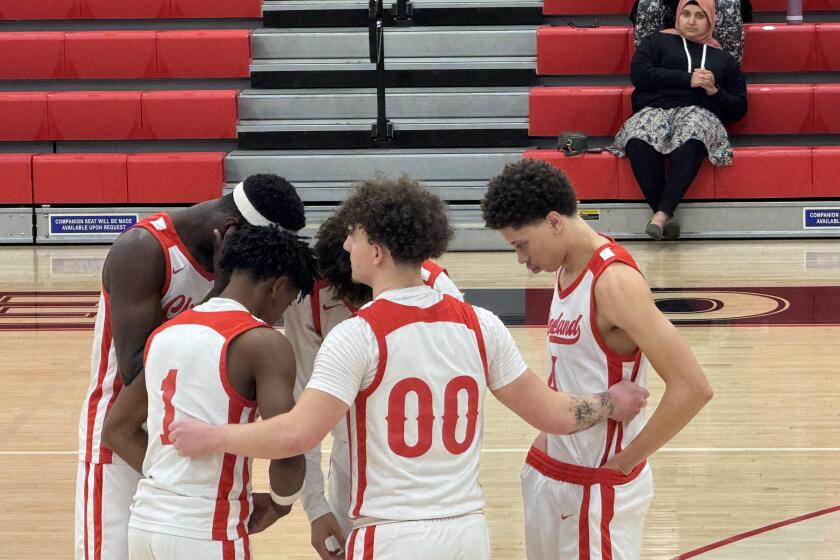Can NFL Sell Itself to City of the Future?
- Share via
Today marks the beginning of the annual ritual in which the National Football League tries to convince Americans that pro football, rather than baseball, is the national pastime. I refer, of course, to the week leading up to next Sunday’s NFL championship game or--as NFL marketing geniuses long ago dubbed it--the Super Bowl.
For the next seven days it will be well nigh impossible to watch television, listen to the radio, or read a newspaper or magazine without coming across news items, features and commercials hyping Sunday’s game.
But this year things will be different. For the first time, major news media are questioning the NFL’s hype. And that should strengthen the resolve of those of us who would like another NFL team in Los Angeles someday but who also believe that the NFL needs Los Angeles more than we need them.
I first made that point several months ago, in arguing that any local civic or business leaders who negotiate with the NFL for a new franchise should not cave in to the league’s demands for a fancy, expensive new football stadium as a precondition. Even as the pre-Super Bowl hype reaches fever pitch, evidence is emerging that I was right.
As predicted, TV ratings for NFL games declined again this season, to such a level that advertisers (according to the Wall Street Journal) worry that this year’s Super Bowl will have some of the lowest ratings ever.
Add to this the NFL’s continued turmoil over franchise moves and drug and sex scandals involving big name players, and it is no surprise that the New York Times recently suggested that “football is losing its hold on the American public.” Headlined “Nobody’s Watching Anymore,” that report quoted Nielsen Media Research experts who confirmed that the NFL’s TV ratings are plummeting.
The lack of a team in Los Angeles, the country’s second-biggest media market, was a big factor in the ratings slump, as were mediocre teams in New York and Chicago and a lame-duck team in Houston that will flee to Nashville in 1998.
NFL spin-doctors will no doubt try to explain away this declining popularity during the buildup to the Super Bowl. But there is no denying that after more than three decades of growth, pro football has serious problems. And they will only worsen if the NFL doesn’t get back into the city that is in many ways a laboratory of the future--Los Angeles.
I’m now convinced that the NFL doesn’t just need Los Angeles to give its TV ratings a short-term boost. It needs Los Angeles in the long run, to find ways to promote NFL football in a rapidly changing national and international marketplace. For, while NFL executives are loath to admit it, they have a demographic problem with their current audience.
Pro football was born in the industrial cities of the Midwest in the 1930s, and still appeals largely to an audience strikingly similar to the fans it drew back then: working-class men. But today, like the manufacturing industries of the Rust Belt, the NFL’s prime audience is aging, shrinking and losing the prosperity it once knew.
Meantime, pro football can’t seem to find a new fan base. Women are largely indifferent. Young men are spending more of their time (and money) on participation sports like bicycling and snowboarding, and if they like a spectator sport, it’s most likely basketball. And all the new immigrants to this country, whether from Europe, Latin America or Asia, prefer soccer.
Speaking of soccer, Los Angeles sports fans will prove once again this afternoon that they get along quite well without pro football. More than 60,000 people will show up at the Rose Bowl for a soccer match between the national teams of Mexico and the United States. A second game on Wednesday is expected to draw a similar crowd to the old Pasadena stadium.
A little more than 60,000 people showed up in 1967, when the first Super Bowl game was played in the Los Angeles Memorial Coliseum. That was considered a disappointing crowd in a stadium that seats more than 90,000, and many wondered if a pro football championship game would ever catch the public’s imagination the way baseball’s World Series does.
Eventually it did, of course. But taste and mores change--as even baseball found out--and the NFL’s declining TV ratings suggest that another change is underway. As is usually the case when big change occurs, Los Angeles is in the forefront.
So if the NFL wants to stay ahead of the curve, it would be well advised to get back into Los Angeles sooner rather than later. Then it will at least have a chance to compete for the younger, more ethnically diverse audiences that are emerging in this ever-changing country.
If they don’t, the annual Super Bowl ritual that began in this city 30 years ago could eventually die here--and a lot sooner than the NFL’s smug overlords realize.
More to Read
Go beyond the scoreboard
Get the latest on L.A.'s teams in the daily Sports Report newsletter.
You may occasionally receive promotional content from the Los Angeles Times.










